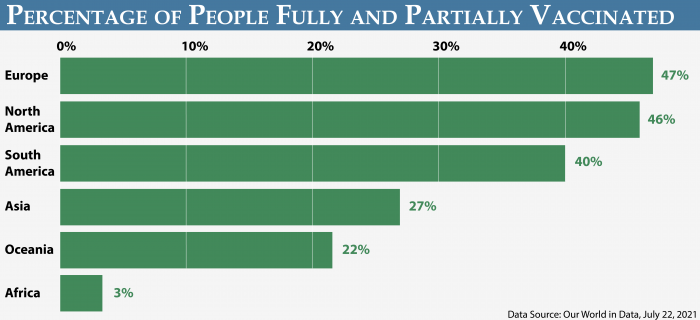Despite the rapid development of effective vaccines and drug companies’ assurances that enough doses will be available by the end of the year to vaccinate the majority of the world against COVID-19, many countries are yet to meet the 10% target.
The World Health Organization‘s strategy to achieve global Covid-19 vaccination by mid-2022 included the following coverage times:
- 10% coverage in all countries by the end of September 2021
- 40% coverage in all countries by the end of December 2021
- 70% coverage in all countries by the end of June 2022
It is safe to say that the 10% target was not met, given that 56 countries, representing 20% of the global population, have yet to meet it. Most of these countries are in Africa and the Middle East.

Here are reasons why poorer countries have been unable to meet the target set by WHO:
Distribution challenge
Africa has previously demonstrated its ability to run mass vaccination campaigns, as evidenced by polio, yellow fever, and, most recently, the Ebola outbreak. However, with the rapid spread of Covid-19, Africa has faced a few logistics and distribution issues.
According to the Africa Center, these include reassessing priority populations for vaccines with potentially short expiration dates, as well as ensuring capacity for the ultra-cold chain infrastructure required for some of the vaccines.
It also includes securing funding and transportation to allow vaccination campaigns to reach rural areas, as well as training health care workers in the nuances of administering each of the COVID vaccines that may be available.
Unequal vaccine rollout
According to One campaign, wealthy countries have purchased the majority of the supply and are stockpiling even what they do not require. Meanwhile, low- and middle-income countries are struggling to disseminate the doses that are available.
So far, 82 per cent of vaccine doses have been administered to people in wealthier parts of the world, while less than 20 per cent of vaccines have been administered to people in poorer countries.
Inadequate education
Many African countries remain skeptical of the vaccines, owing to rumours that the Covid-19 vaccines are a government conspiracy or that people taking them all over the world are dying. Fear and misinformation must be addressed, and people must be properly educated and informed.
Some countries like the Democratic Republic of the Congo, are struggling to distribute the vaccines they do have because of concern over their side effects and gaps in healthcare infrastructure.
Misinformation
Some people believe that there is no coronavirus in their country. They do not see the need to take the vaccines. Statistics and infographics should be distributed across the country so that people are aware of what is going on.
African countries should be at the top of the list of those receiving these doses, as the continent has some of the world’s highest fatality rates.
Before significant quantities of vaccines arrive, we must prioritize and prepare vulnerable populations, vaccination sites, and cold-storage facilities, negotiate logistical challenges, train health care workers, and conduct ongoing public education campaigns.
Viruses have no regard for borders or socioeconomic status. We are all vulnerable to new variants of COVID-19 if it is allowed to circulate unchecked anywhere in the world.
